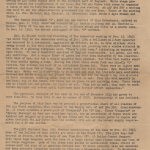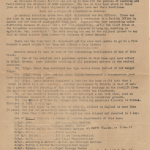History of 4th BAD
[A typewritten insert included in the previous letter.]
HISTORY OF 4TH BAD
The 9th Air Force arrived in the UK, and of course, it was necessary to have an Air Force Service Command–––the 9th. During Sept. 1943, Gen, John Clark decided upon having an Air Corps Supply Base in the southern part of England. While steps proceeded toward the construction of our base, the 9th Air Force took steps to organize a cadre of men to form the Base Hdqrs, for the new station. At AAF Sta 590 a meeting was held to lay the administrative groundwork for the new Base. Those at the meeting were: Lt. Col. Shively, Maj. Kinsley, Lt. Schoulder, Capt. Meeks & Sgts Stemen and Engler.
The famous detachment "F", that is, one hundred of this Detachment, arrived at Dinton, Dec. 7, 1943, under the command of Lt. Martin Goldberg and Lt. Charles L. Moore. Fifty of the men were quartered in Dinton House and fifty at a nearby camp. On Dec. 13, 1943, the second contingent of Det. "F" arrived.
Maj. P. Boland tells the following of the momentous morning of Dec. 13, 1943: "At about 8:45 on the momentous morning of Dec. 13th a brilliant military maneuver was executed by a determined, aggressive QM Officer, as he, in true military style swung around in his well-cushioned swivel chair and pointing out a window situated by the side of a glowing fireplace said, "There’s your camp," indicating an expanse of open field. It was a beautiful specimen of English countryside. All green, all wet, all uninviting. Not a single blade of grass had ever been disturbed by the constructive hand of man, nor had a single Squadron been planned. Yet from that humble start in four months sprang a camp. During the first three weeks food was chiefly "C" rations, the kitchen was half of an unfinished Nissen hut. There were no lights save candles, and damn few of them. The stoves were two field ranges. Sgt. Benedict was Mess Sgt. Water was limited–––had to be hauled and only two trailers were available. Rations had to be wrangled and fought for. The men ate two meals a day out-of-doors in total darkness, standing ankle deep or better in mud. They ate with messkit in one hand, cup in the other, for there was no place to put anything down. Their tents had no floors but wet ground, no lights at all. They got no mail, they went to work before daylight and worked until blackness made further effort impossible."
The personnel strength of the base by the end of December 1943 had grown to more than 600. By June 1944 it was in excess of 3000. Subsequently it has declined.
The purpose of this Base was to process a proportional share of all classes of 9th Air Force supplies, then handled by the Supply Div. of AAF Sta 590. Simultaneously, it would assemble a stock-pile of "Compacks" for "D" Day. These "Compacks" or "Kelley Packups" as they are sometimes called, are an assortment of boxes which are handled and shipped as a group. In the boxes are the necessary parts to supply any given tactical 9th Air Force Unit (in combat) with all at its normal supply requirements for a 30 day period.
The 333rd Engineer Reg. (SS) started construction of the base on Nov. 20, 1943. Some of the fellows of that outfit are still on the field (?). The 333rd Reg. had erected at Dinton, with the help of men from Det. "F", 10 Butler Combat Hangars. Into these huge hangars, each the size of a large circus tent flowed tons and tons of Air Corps supplies. Some of the items came packed in match-sized boxes, others in crates half the size of an American freight car. To store properly this war material and keep accurate inventory records on them was a tremendous project. To warehouse this equipment required 23 hangars. To keep stock records and handle incoming requisitions required 6 Property Accounting units, known as Property Accounting "A" through "G". Each one of the six was housed in a Nissen hut.
It became necessary on Apr 2. 1944 to create a night shift which worked from 1700 to 2400 hours. During the month of May, Air Corps supplies totaling nearly 12,000,000 pounds were processed. At the end of May the Depot ceased filling requisitions of the Six Tactical Air Depots of the 9th Air Force, and subsequently, all shipments from this Base were made on orders from Sta 590.
An Overseas Shipment Section was set up in June for the purpose of handling and facilitating the shipment of DSSD supplies. The men on this base stuck to their jobs so well that all depot shipments of supplies have met their deadlines.
Here are a couple of illustrative stories:
An unusual situation arose when Capt. Hildebrand was S-4 Officer. There was the time he was conversing over the phone with a contractor in a British Office in London for 100 tons of cinders for road work. Negotiations were proceeding under difficulty because of static and a bad line connection. After the third break in the telephone conversation, Capt. Hildebrand prepared to hang up, mumbling in agitation, "Ah, horseshit." The next evening the men at the railhead phoned to say that an order arrived from London–––3 carloads of horse Manure!
There was the time that Lt. Blandhard and his crew were unable to go to a fire because a guard wouldn’t let them out without a trip ticket.
**********************************
Mention should be made of some of the outstanding developments of men of this field:
Men of Sec. 1 that are in charge of various departments of this base:
M/Sgt. Horney. . . . . . . .Depot Supply Office
M/Sgt. Hilton &T/Sgt. Charley-Overseas Section1
M/Sgt. Stone . . . . . . . .Stock Records
1st Sgt. Bailey. . . . . . .Air Corps Transportation
T/Sgt. Guilds. . . . . . . .Air Corps Transportation
S/Sgt. Armstrong & Abshure..A.O.G. and Teletype Section
S/Sgt. Harvey & Walter Heyner.Typewriter Repair
S/Sgt. Equale. . . . . . . .Depot Message Center
S/Sgt. Sharff. . . . . . . .Depot Personnel2
Sgt. Guelker . . . . . . .Statistical Control
Sgt. Prendergast . . . . .Central Files
1 handwritten on this line: “My bosses from Dec. ’44 to Nov. 45 ”
2 handwritten on this line: “My Boss from April ’44 to Dec. ’44.”


